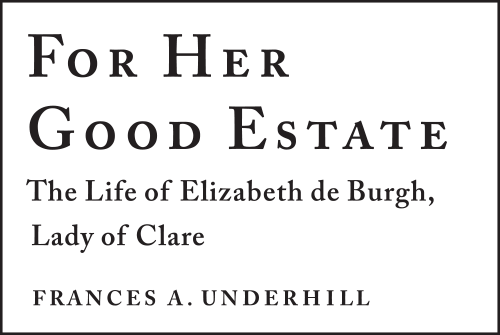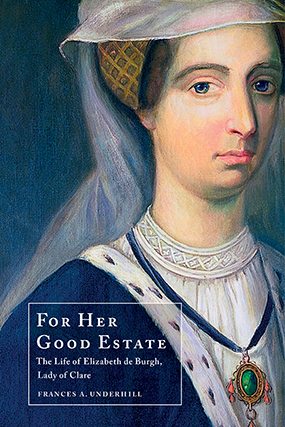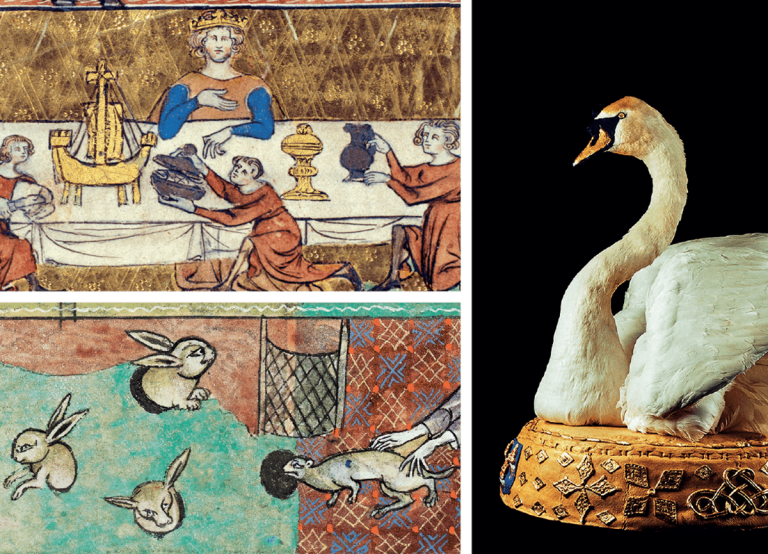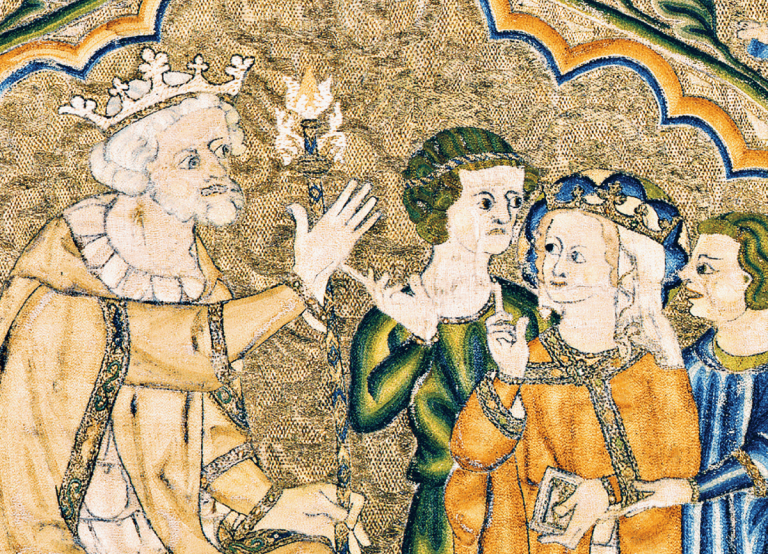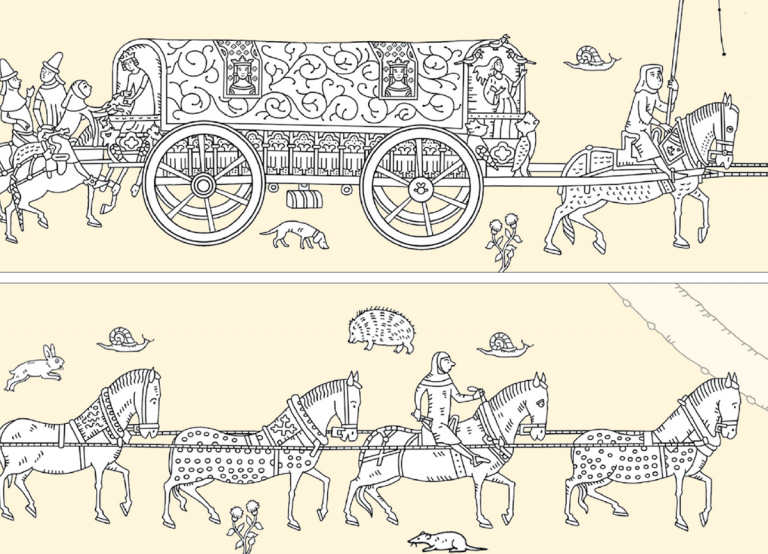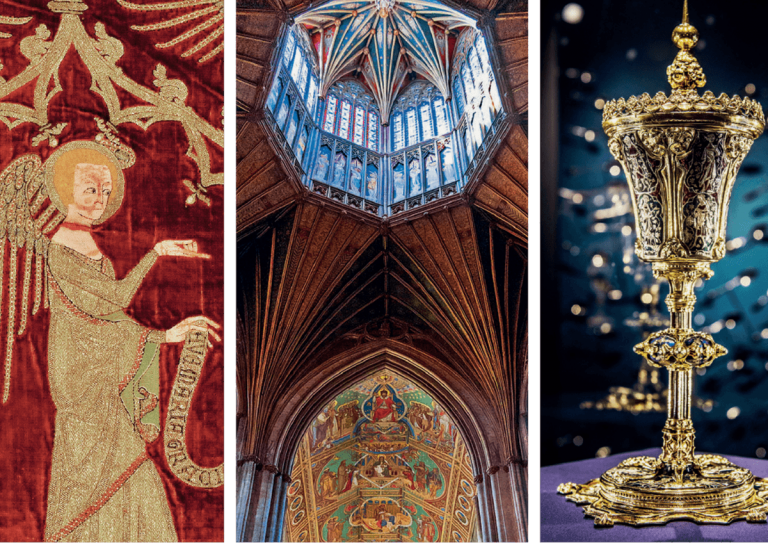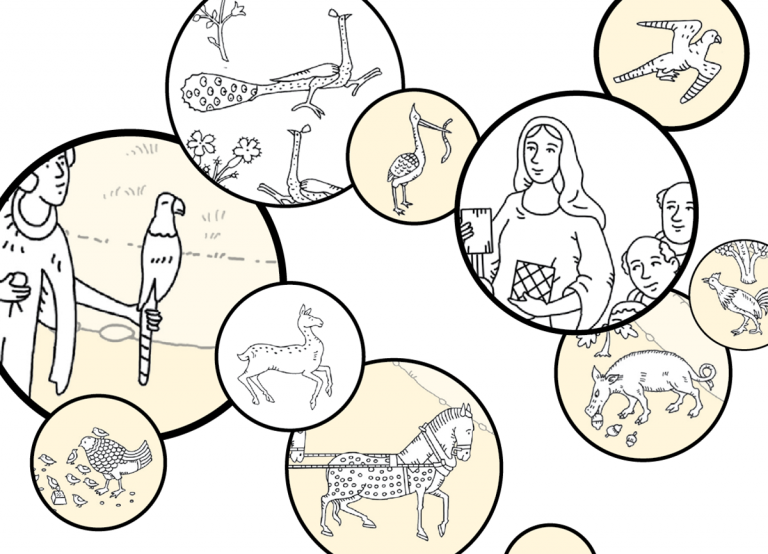


1326. England faces invasion. Keep calm and
… sew protective garments. Strengthen defences. Prepare legal testimony. Gather info; maintain communications. Regain lost lands. Repair & redecorate. Thank friends and supporters. Celebrate with a Christmas banquet.
Taking us back to the Middle Ages…
Seafood, game birds and animals in gourmet variety. Wine from the Rhine and afar. Prunes from Damascus. Almonds for the parrot. Sugar and spice. Serve with style.
Medieval women, demure and defenceless?
Petitioned Parliament year after year. Defied kings, thugs and monopolists. Limited power, extraordinary influence.
Best friends support each other’s projects…
Three Cambridge colleges. Works of art & literature. Legacies that inspire, more than six centuries on.
Seven extra horses to carry home the book purchases…
… those books may be lost, but the influence of her support to scholars and bookmakers lives on.
East Anglia was booming, and English craftmanship coveted by kings.
Trendsetting architecture. Fine artistry; skilled craftsmen. Prosperity from farming, fishing & trade. Ideas & scholarship. Between wars & plague, a golden age.
The art of the perfect gift…
… delicious, exquisite, exotic, or fun… for friends of all ages. Legendary hospitality. Lifelong affection.
Let there be music!
… for processions… and festivities… The organ must be back for Christmas. Church services With Notes! Centuries later, Clare College Choir sings on.
Elizabeth de Burgh showed feisty spirit in adversity and imprisonment, war and plague – and she and her friends were influential patrons of books and all arts while English craftsmanship was at its finest. Her legacy includes Clare College and Clare Hall in the University of Cambridge, and a treasure trove of records illuminating the contrasting reigns of her uncle Edward II and cousin Edward III.
Her early life was tumultuous: an arranged marriage; an abduction leading to a clandestine second marriage; a forced marriage to a royal favourite who died a traitor. At age 26, she had been widowed three times, with a child from each marriage. She suffered arrest, confinement and asset confiscation during years of civil war, before regaining control of her estates after Queen Isabella’s invasion. Empowered by a vow of chastity to ensure her independence, she thrived in her long widowhood as a capable administrator, an engaged mother and grandmother, with a talent for enduring and multigenerational friendship. She became a shrewd philanthropist, founding the Franciscan friary at Walsingham and endowing Clare College, Cambridge.
Frances Underhill’s biography shows how Elizabeth overcame gender barriers to attain both prestige and lasting influence. Additional essays in this edition explore the events of 1326, and Elizabeth’s later place in the network of artistic patronage at a time of enduring architectural treasures, fine textiles and beautiful manuscripts. Centuries later, her ringing introduction to the Clare College statutes continues to inspire, and new generations of scholars pursue the Precious Pearl of Learning.
ISBN: 978-1-9163768-9-2 (hardback), 978-1-9163768-0-9 (paperback)
Foreword by Dr Jacqueline Tasioulas
Foreword by Professor Paul Binski
Chapter 1 Elizabeth’s Life: An Overview
Chapter 2 Her Good Estate
Chapter 3 Family and Friends
Chapter 4 Politics and Patronage
Chapter 5 Piety and Prestige
Chapter 6 Judgments
ADDED IN SECOND EDITION
Appendix 1 1326, a pivotal year: Queen Isabella’s invasion – Jennifer Ward
Appendix 2 1326: Elizabeth’s protest against the Despensers – Jennifer Ward
Appendix 3 Bibliophile cousins: the Bohun family – Jennifer Ward
Appendix 4 Elizabeth’s book bequests to Clare College – Margaret M. Smith
Appendix 5 Elizabeth’s will: other bequests – Claire Barnes
Appendix 6 Clare College statutes of 1359 – Claire Barnes
Appendix 7 Elizabeth’s bell – Mary Bliss & Jim Woodhouse
Appendix 8 Editor’s notes to second edition – Claire Barnes
Feature: Elizabeth’s personal and college seals – Margaret M. Smith & Claire Barnes
Other illustrations: 24 colour pages, plus 2 black-and-white
Maps: 2 pages
Genealogy: 4 pages
Glossary
Abbreviations
Notes
Bibliography
Dedications and acknowledgments: first edition, second edition
Illustration list, notes and credits
Index
Hardback only: endpapers depicting Elizabeth at Clare Castle and Walsingham Friary, inspired by contemporary manuscripts and drawn by Colin King.
Hardback materials are of archival quality, as befits the longevity of Elizabeth's legacy and the artistic splendours depicted. The papers are Munken Pure and Meridien Silk, bound parallel to the grain with Eska boards, Canapetta book cloth from Tele Legatoria, and a French fold jacket. Inks were customised to evoke medieval manuscripts, and ribbons dyed in bespoke Clare colours to keep track of genealogy, story and notes.
Frances A. Underhill taught medieval history at the University of Richmond for twenty-eight years and was Professor of History, Emerita, from 1991 until her death in 2017. She loved teaching and interacting with students, and received the Distinguished Educator Award three times. For Her Good Estate reflects Professor Underhill’s fascination with Elizabeth, a complex and evolving woman, and how her devotion, determination, expanding vision and purposeful creativity produced an intellectual legacy that has endured for centuries.
Dr Jennifer Ward spent much of her career teaching and researching at Goldsmiths College, University of London. She has written extensively on medieval women, and is still making new discoveries in the voluminous archives relating to Elizabeth, a lifelong interest.
Dr Margaret M. Smith is an alumna of Clare Hall, retired reader in Book Design History at the University of Reading, and Honorary Curator of the Clare Ancient House Museum.
Jim Woodhouse is a Fellow of Clare College and Professor of Structural Dynamics at the University of Cambridge, with a special interest in acoustic vibration.
Dr Jacqueline Tasioulas is a lecturer in medieval English literature at the University of Cambridge, and the Senior Tutor of Clare College.
Paul Binski is a Fellow of the British Academy and Professor of the History of Medieval Art at the University of Cambridge.
Claire Barnes was the grateful recipient of a Foundation Scholarship during her undergraduate years at Clare College but never attained any position in Church, State, or Academia, so was delighted to help with this book.
FROM REVIEWS TO THE FIRST EDITION:
Elizabeth de Burgh… is the benefactor of all medievalists in the sense that her efficient management of her estates generated detailed records, unrivaled as sources for information about daily life, social relations, and cultural mores in her time and place. Moreover, she was conveniently related to all of the major players in the political upheavals of the late Plantagenets… The account of Elizabeth’s life offers a vivid picture of both privilege and precarious existence. As the granddaughter of a king she enjoyed position and wealth, but… women, even in the most privileged class, could be bereft of security and control of their person. The true interest in Underhill’s account, however, is in watching Elizabeth manage very well, maintaining a wide, and widely-scattered, social network on whose support she could draw, and maintaining a loyal network of retainers to protect and promote her interests.
Julia Dietrich, University of Louisville
The Clare accounts have often been drawn on by previous historians, but mainly for particular purposes and never so comprehensively as here… From these pages there emerges a fresh and distinctive personality. Elizabeth was above all both capable and intelligent. She had shown her mettle early on, during the vulnerable first years of her final widowhood in the 1320s, when she had manoeuvred for survival under the tyranny of the Despensers. Thereafter she effectively withdrew from court politics, taking a vow of chastity which freed her from further marital pressures and devoting herself to her children, grandchildren and wider family, an active and hospitable social life, the supervision of a large household and estate, and to good works. Her reading, her educational enterprises (chief among them Clare Hall at Cambridge), and her circle of clerks and churchmen, all suggest a more than conventionally religious and serious-minded lady; though she was also one who moved with brio and élan in secular and aristocratic society. If her close friendship with Henry of Lancaster, author of Le livre de seyntz medicines, might have been expected, her equally close relationship with the Black Prince, her frequent guest in the years after Poitiers, was perhaps less predictable. The affection and respect which she plainly inspired owed something to her little acts of kindness and generosity: the bequest, for example, of her small chariot to its driver, in a thoughtful gesture towards his future employment. Here and in other minutiae – the purchase of almonds for her pet parrots, the gift of two spaniels to her daughter-in-law, Matilda de Burgh – she comes most vividly to life. Her biographer has quarried all this material assiduously, effectively and with quiet good judgement, writing clearly and with a sharp critical sense.
John Maddicott, Exeter College, Oxford
… engaging, detailed, and impressive in its breadth and use of sources… an accomplished, elegant, and thorough study of a fascinating subject.
Linda E. Mitchell, Alfred University
FROM FOREWORD TO THE SECOND EDITION:
We understand Elizabeth as one of the small number of influential patrons who shaped Gothic art and architecture in England. So much was destroyed. Yet tantalising fragments remain, with surviving treasures in wood and gold, silk and stone; we have evidence from both images and words. These allow the imagination to soar, conjuring up a picture of magnificence. Books such as For Her Good Estate touch on so much, and are invaluable in helping us to visualize an entire era.
Paul Binski, University of Cambridge
DOWNLOADS FROM THE BOOK
Foreword by Dr Jacqueline Tasioulas
Foreword by Professor Paul Binski
Elizabeth’s personal and college seals
Maps
Family trees
Glossary
Appendices:
1. 1326, a pivotal year: Queen Isabella's invasion - Jennifer Ward
2. 1326: Elizabeth's protest against the Despensers - Jennifer Ward
3. Bibliophile cousins: the Bohun family - Jennifer Ward
4. Elizabeth's book bequests to Clare College - Margaret M. Smith
5. Elizabeth's will: other bequests - Claire Barnes
6. Clare College statutes of 1359 - Claire Barnes
7. Elizabeth's bell - Mary Bliss & Jim Woodhouse
8. Editor's notes to second edition - Claire Barnes
Copyright page
Illustration list, notes and credits
Index
Jacket images
CLARE COLLEGE SEAL - UPDATE
More recent information on the Clare College seal, the evolution of Elizabeth's heraldry, and new archival and archaeological discoveries, was published in a 2023 booklet, The Clare College Seal & the making of the Seal Sculpture. Booksite and free download: https://barnes1.net/seal/. Printed copies are available from Clare College, with all proceeds supporting the choir.
ELIZABETH'S WILL, SOURCE DOCUMENTS
Original text in French: J. Nichols, ed.; A Collection of All The Wills..., London 1780
English translation by Dr Jennifer Ward
MAPS OF MEDIEVAL CAMBRIDGE
The Historic Towns Atlas shows medieval features on its map “Cambridge in 1800”, and also has maps of medieval hostels and street names, on http://www.historictownsatlas.org.uk/
A map of Cambridge in the 1350s is on the website of a writer of popular novels who has a Cambridge PhD and used to teach there; her real name is Elizabeth Cruwys. She adapted this from a map of Cambridge c.1500 in Damian Riehl Leader, A History of the University of Cambridge: The University to 1546, Cambridge University Press, 1988, pp. 12–13.
https://www.susannagregory.com/wp-content/uploads/2012/08/map1.jpg
Another map of Cambridge c.1350 shows the river wharves, monastic precincts and recently-excavated burial sites, and was published in Dittmar et al, 'Medieval injuries: Skeletal trauma as an indicator of past living conditions and hazard risk in Cambridge, England', American Journal of Physical Anthropology 2021 p.629.
An interactive map from the Museum of Cambridge is at https://capturingcambridge.org/
A map with the medieval buildings of Clare College and its surroundings, along with the plan for King's College which swept many away, is on the page for the vanished church of St John Zachary: https://capturingcambridge.org/centre/trinity-lane/st-john-zachary/
CLARE, SUFFOLK
A Short History of Clare, Suffolk, Gladys A. Ward (née Thornton), revised 1963 edition
Sketch map of Clare in the Fourteenth Century, from G.A. Thornton's 1928 History of Clare
The Medieval Gardens of Clare Castle, Edward Martin, Suffolk Gardens Trust, 2012
Clare, Suffolk, David Hatton, 2004: A-Z Book I, Streets & Houses Book II, Priory Book III, Church of SS Peter & Paul Book IV.
Clare Castle, Andrew Clarke, The Foxearth and District Local History Society, 2020 - not wholly reliable, but with many interesting images
BROMHOLM PRIORY
3D model of Bromholm Priory, a major pilgrimage site visited by Elizabeth in 1347.
MEDIEVAL SOURCES ONLINE
Shortlist by Sara Cockerill, biographer of Eleanor of Castile:
https://www.saracockerill.com/research
BOOK FLYERS
1. 1326: England faces invasion…
2. Taking us back to the Middle Ages… (eating well)
3. Medieval women, demure and defenceless?
4. Friends and patrons
5. Seven extra horses to carry home the book purchases…
6. A golden age of peace, prosperity, ideas, and all the arts
7. Gift-giving and friendship
8. Let there be music!
CORRIGENDUM
Hardback p.245 note 45 should read "For the Feast of the Annunciation..."
CONTACT PUBLISHER
E-mail on copyright page.
TWITTER (old posts)
https://twitter.com/@ClaireFromClare
#LadyofClare
![]()
MASTODON (new posts)
https://h-net.social/@ClaireFromClare
#LadyOfClare
![]()
Buy the limited edition hardback
–all proceeds to Clare College Choir.
Paperback via regular book channels.
